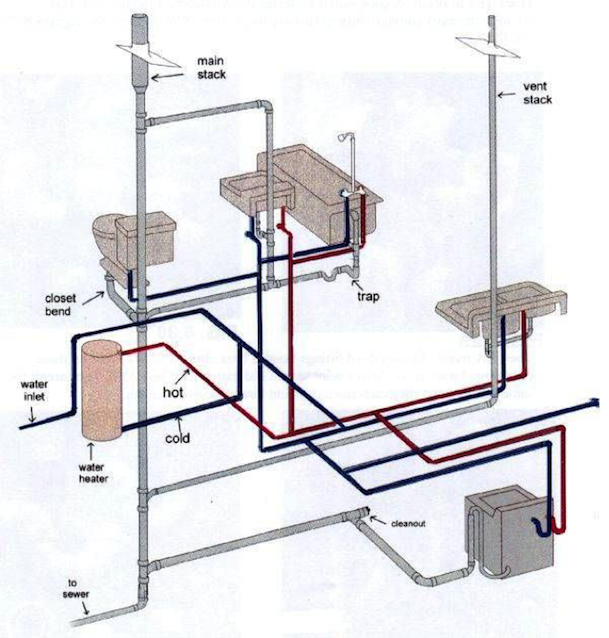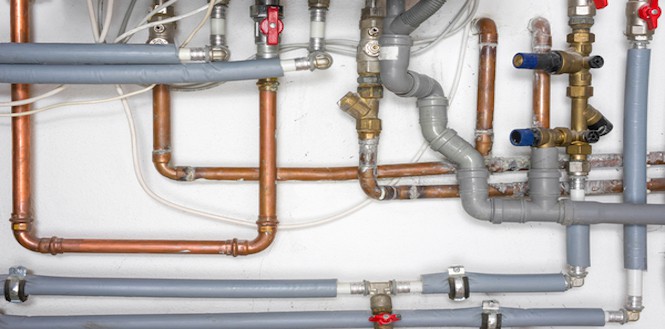The Basics to Your Property's Plumbing System Anatomy
The Basics to Your Property's Plumbing System Anatomy
Blog Article
We've uncovered this post on Understanding Your Home's Plumbing Anatomy directly below on the web and reckoned it made good sense to share it with you in this article.

Comprehending exactly how your home's pipes system functions is essential for every property owner. From providing tidy water for alcohol consumption, food preparation, and showering to safely removing wastewater, a well-maintained plumbing system is important for your household's wellness and convenience. In this detailed guide, we'll discover the detailed network that composes your home's plumbing and offer tips on maintenance, upgrades, and handling common issues.
Intro
Your home's pipes system is more than just a network of pipelines; it's an intricate system that guarantees you have access to clean water and effective wastewater removal. Understanding its elements and exactly how they collaborate can help you protect against pricey fixings and make certain every little thing runs smoothly.
Fundamental Components of a Plumbing System
Pipes and Tubes
At the heart of your pipes system are the pipelines and tubing that carry water throughout your home. These can be constructed from different materials such as copper, PVC, or PEX, each with its benefits in regards to resilience and cost-effectiveness.
Fixtures: Sinks, Toilets, Showers, and so on.
Fixtures like sinks, bathrooms, showers, and tubs are where water is used in your home. Understanding just how these components link to the plumbing system helps in identifying problems and intending upgrades.
Valves and Shut-off Points
Shutoffs control the circulation of water in your plumbing system. Shut-off shutoffs are crucial throughout emergency situations or when you need to make repair work, allowing you to separate parts of the system without interrupting water flow to the whole residence.
Water System System
Main Water Line
The main water line attaches your home to the local supply of water or a private well. It's where water enters your home and is dispersed to different fixtures.
Water Meter and Stress Regulatory Authority
The water meter measures your water use, while a stress regulator makes certain that water streams at a safe stress throughout your home's plumbing system, preventing damage to pipes and components.
Cold Water vs. Hot Water Lines
Recognizing the distinction between cold water lines, which provide water directly from the major, and hot water lines, which lug heated water from the water heater, assists in troubleshooting and preparing for upgrades.
Drain System
Drain Pipes Pipes and Traps
Drain pipes lug wastewater away from sinks, showers, and bathrooms to the sewage system or septic tank. Traps stop sewage system gases from entering your home and also catch particles that could trigger obstructions.
Ventilation Pipes
Air flow pipes allow air right into the drainage system, protecting against suction that could reduce drainage and trigger traps to vacant. Correct ventilation is necessary for maintaining the integrity of your pipes system.
Relevance of Proper Drainage
Making sure proper drain prevents backups and water damages. Routinely cleaning up drains pipes and preserving catches can prevent expensive fixings and extend the life of your plumbing system.
Water Heater
Types of Water Heaters
Hot water heater can be tankless or traditional tank-style. Tankless heaters heat water on demand, while storage tanks keep warmed water for prompt usage.
Upgrading Your Plumbing System
Reasons for Updating
Updating to water-efficient fixtures or replacing old pipelines can boost water quality, decrease water expenses, and raise the value of your home.
Modern Pipes Technologies and Their Advantages
Discover modern technologies like clever leakage detectors, water-saving commodes, and energy-efficient hot water heater that can conserve cash and lower ecological influence.
Price Factors To Consider and ROI
Compute the ahead of time prices versus long-lasting cost savings when taking into consideration pipes upgrades. Lots of upgrades spend for themselves with decreased utility bills and fewer repairs.
Just How Water Heaters Attach to the Pipes System
Comprehending exactly how water heaters connect to both the cold water supply and hot water circulation lines aids in detecting problems like inadequate hot water or leaks.
Upkeep Tips for Water Heaters
Consistently flushing your water heater to remove debris, examining the temperature setups, and checking for leaks can expand its life-span and enhance energy efficiency.
Usual Pipes Problems
Leaks and Their Reasons
Leakages can occur due to aging pipes, loosened fittings, or high water stress. Addressing leakages quickly avoids water damages and mold development.
Blockages and Clogs
Blockages in drains and commodes are typically triggered by purging non-flushable items or an accumulation of oil and hair. Using drainpipe displays and bearing in mind what decreases your drains pipes can stop blockages.
Indications of Pipes Issues to Look For
Low water pressure, sluggish drains, foul odors, or unusually high water bills are signs of potential plumbing issues that must be attended to immediately.
Plumbing Maintenance Tips
Regular Inspections and Checks
Schedule yearly pipes examinations to capture issues early. Look for indicators of leaks, corrosion, or mineral build-up in faucets and showerheads.
DIY Upkeep Tasks
Easy jobs like cleaning tap aerators, looking for toilet leaks using color tablets, or shielding subjected pipes in chilly climates can stop major pipes issues.
When to Call a Specialist Plumbing
Know when a pipes issue requires specialist know-how. Attempting intricate repair services without appropriate knowledge can bring about more damages and greater repair work prices.
Tips for Minimizing Water Usage
Simple behaviors like dealing with leakages promptly, taking much shorter showers, and running full tons of washing and meals can preserve water and lower your energy bills.
Eco-Friendly Plumbing Options
Take into consideration sustainable pipes materials like bamboo for flooring, which is durable and green, or recycled glass for counter tops.
Emergency situation Preparedness
Steps to Take During a Plumbing Emergency situation
Know where your shut-off shutoffs are located and just how to turn off the supply of water in case of a ruptured pipe or major leakage.
Importance of Having Emergency Calls Handy
Keep call information for regional plumbers or emergency solutions conveniently available for quick action throughout a plumbing dilemma.
Ecological Influence and Conservation
Water-Saving Fixtures and Home Appliances
Mounting low-flow faucets, showerheads, and toilets can substantially lower water use without sacrificing performance.
Do It Yourself Emergency Situation Fixes (When Relevant).
Temporary repairs like utilizing air duct tape to spot a dripping pipe or placing a bucket under a leaking faucet can lessen damages till a professional plumber arrives.
Conclusion.
Understanding the anatomy of your home's plumbing system equips you to preserve it successfully, conserving money and time on fixings. By adhering to normal upkeep regimens and remaining educated concerning modern plumbing technologies, you can ensure your plumbing system operates efficiently for years to come.
The Anatomy of Your Home s Plumbing System
Understanding the anatomy of your home s plumbing system is essential for any homeowner. It not only helps in identifying potential issues but also facilitates effective communication with professionals when repairs or upgrades are needed. Your home s plumbing system is more than just pipes and faucets; it s a complex network that ensures the efficient and hygienic flow of water in and out of your house. In this blog, we ll dissect the crucial components of your home s plumbing system. For those in Antelope Valley, Brock Plumbing is your trusted partner for all your plumbing needs, ensuring your system functions smoothly and efficiently.
Water Supply System
Main Water Line: This is where your home s plumbing system begins. The main water line connects your home to the public water supply or a private well. Pipes and Shut-off Valves: Pipes distribute water throughout your home. Shut-off valves are crucial for controlling the flow of water and making repairs without shutting off the entire system. Drainage System
Drain Pipes: These pipes carry waste and water away from sinks, toilets, and showers. Vents: Vents allow sewer gases to escape and help maintain proper pressure in the drainage pipes, ensuring efficient flow of wastewater. Traps: Every fixture has a trap, a U-shaped pipe that holds water and prevents sewer gases from entering your home. The most common is the P-trap under sinks. Fixtures and Appliances
Fixtures and appliances are the most interacted with parts of your plumbing system. They include sinks, toilets, showers, dishwashers, and washing machines. Each fixture and appliance has its own supply and drainage connection, ensuring they receive clean water and can dispose of wastewater effectively.
Water Heating System
Your water heater is a crucial component, providing hot water to various fixtures and appliances in your home. It can be tank-based or tankless, with each type having its own set of advantages and maintenance requirements. Regular maintenance is essential to ensure efficient operation and extend the lifespan of the unit.
Sump Pump
In areas prone to flooding or with high water tables, a sump pump is an essential part of the plumbing system. It s installed in the lowest part of your basement or crawlspace and pumps out water that accumulates, preventing flooding and protecting your home from water damage.
Septic System
Homes that are not connected to a municipal sewer system have a septic system and an underground wastewater treatment structure. Understanding how to maintain your septic system is crucial to prevent backups, odors, and early system failure.
Conclusion
Your home s plumbing system is a complex and essential network, ensuring the efficient and hygienic flow of water in and out of your property. Understanding its key components helps in maintaining it properly and identifying issues before they escalate into major problems. For residents in Antelope Valley, Brock Plumbing is dedicated to providing top-notch services, ensuring that every part of your plumbing system is in perfect working order. Trust our team of professionals to handle all your plumbing needs, ensuring your home remains comfortable, safe, and well-maintained.
https://brockplumbinganddrains.com/blog/the-anatomy-of-your-homes-plumbing-system/

Hopefully you enjoyed our article about Exploring Your Homes Plumbing Anatomy. Many thanks for spending some time to read through our short article. Enjoyed reading our review? Please quickly share it. Let another person check it out. Thanks for going through it.
Free Estimates Report this page